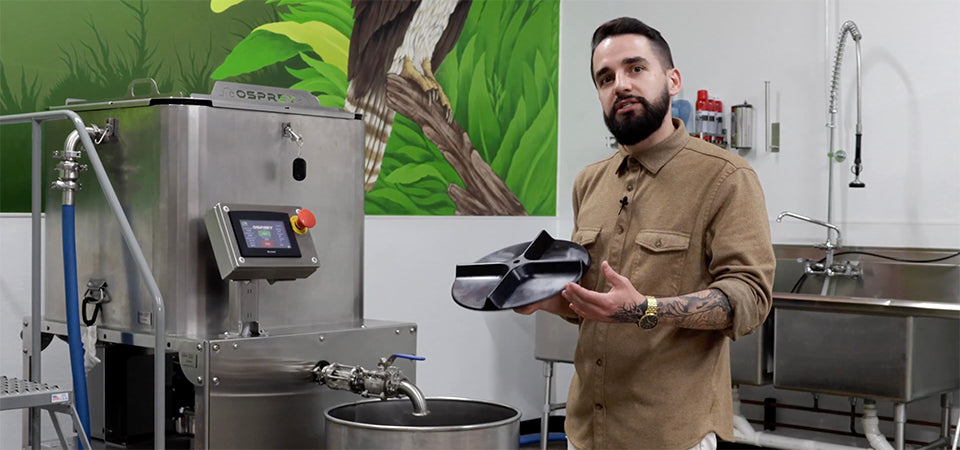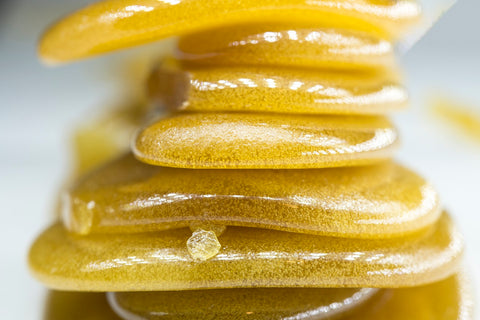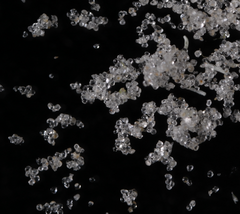Solventless Extraction 101 - Comprehensive Guide

Solventless extraction started with old-world kief bricks and hand-rubbed charas and has evolved over the past few decades with the introduction of bubble hash washing machines, rosin presses, and freeze-dryers to the hashmaking space.
Professional and novice extraction enthusiasts can benefit immensely from learning about the range of solventless extraction methods and SKUs that are currently possible. Not only are these SKUs extremely satisfying (and accessible) to make but are also highly lucrative.
What Does "Solventless Extraction" Mean?
"Solventless extraction" in cannabis refers to methods of separating the resin or oil from cannabis flower without using solvents like CO2, ethanol, or light hydrocarbons (butane, propane, hexane, etc.).
Whereas solvents separate the cannabinoids, terpenes, and other compounds in cannabis via chemical dissolution, solventless extraction methods utilize mechanical separation. This may involve agitation alone, ice water and agitation, or a combination of heat and pressure.
Types of Solventless Concentrates by Extraction Method
The different kinds of solventless concentrates can be categorized according to the extraction process used. As mentioned above, they are:
- Agitation alone (sifting, tumbling, or rubbing)
- Ice water and agitation
- Heat and pressure
Agitation Alone
Agitation is the oldest solventless extraction method and one that has evolved over time. “Agitation” can involve sifting, tumbling, or using your hands or gloves to collect the resin.
Old-World Hash
Traditional hashmakers in Central Asia and the Middle East would shake or rub dried cannabis flower over a sieve to collect the resin-containing trichomes and compress the trichomes using pressure and heat to form them into bricks and balls.
Charas
Charas (finger-hash sticks) are made a little differently. Instead of shaking or rubbing dried cannabis flowers, the sticky trichomes would be collected by rubbing fresh flowers with one's fingers and then forming the sticky residue into sticks.
Modern Kief and Dry Sift
Modern cannabis concentrates that are made with agitation are much more refined than their traditional counterparts. While many hobbyists still collect and smoke kief (the unrefined mixture of trichomes and plant material that falls through to the bottom of your cannabis grinder), commercial producers make a much more highly refined and terpene-rich version by tumbling fresh frozen plant material at sub-zero temperatures, freeze drying the resulting live “sift,” and removing most of the residual plant material using static technology.
Ice Water and Agitation
Ice water extraction has been around for decades. However, more recently, commercial hash washing equipment has made it significantly easier to produce ice water hash, or bubble hash, at scale.
Bubble Hash (Ice Water Hash)
Bubble hash or ice water hash is a whole-trichome extract that is made by agitating frozen cannabis flowers in ice-cold water. The frozen trichomes separate from the plant as a result of the agitation and fall to the bottom of the wash vessel. They are then collected in a graduated series of mesh bags by size when the water is emptied into a second vessel. The trichomes are then dried and either used to make other products or stored.
Bubble hash is often used as a preliminary step before making rosin (more on this below) as this extract will always produce the highest quality rosin. For best results when making bubble hash:
- Use fresh frozen flower.
- Keep your wash water to around 34-35°F.
- Keep the wash room at 50°F or below.
Once the extraction process is complete, freeze dry the bubble hash rather than air drying it for maximize terpene preservation.
Piatella
Piatella is a fairly recent innovation (it was introduced by Uncle’s Farm in 2020) that essentially consists of full-melt live bubble hash that is pressed lightly, wrapped in food-grade plastic, and cold-cured for an extended period.
Over time, terpenes are released from the trichomes and transform the consistency of the slab into one that is budder-like and (ideally) slices like a loaf of bread. Thanks to its high level of purity, piatella can be dabbed directly without first pressing it to extract the rosin.
Temple Balls
Temple balls are made by rolling a wine bottle filled with hot water over dried bubble hash (placed inside a turkey bag) and rolling the semi-melted bubble hash into a ball.
The technique was inspired by the temple balls made by Nepalese monks in times past and is known to help protect the trichomes inside the ball from degradation—even when the ball is stored at room temperature.
Heat and Pressure
A certain amount of heat and pressure is used for making old-world hash bricks and temple balls. However, rosin and its derivatives take this process to a whole new level.
Rosin
Rosin was discovered in 2015 when Phil "Soilgrown" Salazar pressed hash and then dry flower with a hair straightener and noticed that oil separated from the plant matter. This oil left very little residue behind when dabbed. Dedicated rosin presses were later developed that had large rectangular heated plates and could apply a large amount of pressure. These presses are designed to extract much larger amounts of rosin from cannabis material than is possible with a hair straightener.
Rosin essentially consists of the filtered oil of the cannabis plant. Under heat and pressure, the cuticles of the trichome heads melt and the oil inside the trichomes flows out. This oil is filtered when it passes through the tiny holes in the mesh rosin bag, leaving the plant material and trichome cuticles behind. The result is a concentrate that is more refined than extracts like dry sift and bubble hash.
Flower Rosin
Flower rosin is the easiest for those at home looking to make an extract quickly and affordably. To make rosin from flower, dried flower is simply packed into a rosin bag which is tucked inside folded parchment paper and pressed between the heated plates of the rosin press.
Hash Rosin

Hash rosin is pressed from bubble hash rather than dry flower. The resulting rosin is much purer, of a lighter color, and has less of a "green" flavor when dabbed.
Kief Rosin and Dry Sift Rosin
Rosin can also be pressed from kief or dry sift (the refined version of kief). These rosins represent a middle ground between flower rosin and hash rosin and are generally used to make edibles rather than dabbed.
Live Rosin
Live (hash) rosin is made from bubble hash that is washed from fresh frozen cannabis flower rather than dried and cured cannabis flower. This retains more of the volatile terpenes such as monoterpenes that are often lost in the drying process (especially during sun drying, microwave drying, and oven drying). Consumers value live rosin highly because the terpene profile reflects that of the plant at the time of harvest. Live rosin generally sells at the highest price point of all solventless concentrates.
Products that Can Be Derived from Rosin
Several products can be derived from rosin. Live hash rosin is often used as the basis for these products thanks to its superior terpene profile and purity.
Rosin Cartridges
You can make 100% solventless rosin cartridges by heating rosin in a sealed jar. This process turns the rosin into a liquid.
Terpene Sauce
Terpene sauce can be extracted from rosin in two main ways:
- By pressing bubble hash very slowly at low temperatures in a rosin press.
- By heating rosin at low temperatures over an extended time (referred to as heat-curing rosin) until the THCA nucleates and separates from the terpene sauce.
Terpene sauce can then be used to liquefy rosin for carts or can be dabbed or vaporized directly.
THCA
THCA crystals can be separated from rosin by pressing the rosin at graduated temperatures in a rosin press, starting at a low temperature between 130°F and 140°F. You will see a white powder left behind in the rosin filter. That is the THCA.
Solventless-Infused Products
Cannabis flower, kief, dry sift, bubble hash, rosin, and THCA can all be infused into topicals, edibles, and beverages. Food-grade solventless concentrates are typically used in edibles and other "infused" products whereas premium-grade solventless concentrates are dabbed.
When infusing any solventless extract into a topical product, beverage, or edible—such as to make cannabis gummies—the extract must be decarboxylated first to activate the psychoactive compounds in the plant. You can decarb rosin by heating it at 220°F to 250°F for 25 to 30 minutes (or longer, if needed).
FAQs about Solventless Extraction
What Is the Difference between Solventless and Solvent-Based Extraction?
Solventless extraction separates the active compounds from cannabis plant material using mechanical means whereas solvent-based extraction dissolves the active compounds using a solvent.
What Is the Difference between Solventless and Solvent-Free Concentrates?
Solventless concentrates are made without the use of solvents. Solvent-free concentrates are made with the use of solvents and then all of the residual solvents are purged from the concentrate.
What Are the Benefits of Solventless Concentrates?
Solventless concentrates offer the following benefits for consumers:
-
Flavorful: The mechanical means used to make solventless concentrates conserve the integrity of the plant material's cannabinoid and terpene profile.

- 100% chemical-free: No chemicals are used in the extraction process, so there is zero chance of residual solvents being present in the final product.
- "Authentic" or old-school: Solventless concentrates may be considered more authentic, traditional, or old-school because they are more similar to traditional extraction methods and don't require a C1D1 lab and expensive, complicated equipment to make.
- Quality assurance: With solventless, what goes in is what comes out. Solventless extraction methods don't get rid of things like mold, yeast, or bacterial contamination, so solventless concentrates that have passed quality testing must have been made from starting material that was healthy and clean.
Solventless extraction also offers multiple benefits for extractors:
- Accessible: Solventless extraction doesn't typically require the same permits and licenses that are required for hydrocarbon extraction.
- Cost-effective: Solventless extraction equipment typically requires a lower initial investment than solvent-based extraction equipment and the SKUs produced sell at a higher price point in dispensaries than their solvent-based counterparts.
- Perception of quality: Premium solventless concentrates are highly regarded by cannabis connoisseurs for their purity and flavor. Likewise, brands that produce exceptional solventless products are likely to be perceived as “artists” and as keeping their customers' best interests at heart.
What Are the Factors that Influence Quality With Solventless Extraction?
The quality of solventless concentrates is primarily influenced by your:
- Starting material: Fire in, fire out.
- Equipment: The best equipment gives you full control and customization for reliable, replicable results. Your equipment should also be extremely well built so that it lasts you a lifetime and won't fail you or need to be replaced every few years.
- Process: The temperatures, times, and pressures applied to your starting material have a massive influence on the result. In many cases, these parameters are what determine whether you end up making rosin budder, rosin shatter, rosin jam, or terpene sauce (for example) from the same starting material.
Which Is the Best Solventless Extraction Method?
All solventless extraction methods have advantages and (precious few) disadvantages. However, the best solventless extraction method(s) for you will depend on:
- The amount of space you have
- Your ability to control the temperature of the room
- Your budget
- How serious you are about marketing solventless concentrates commercially
- The SKUs that inspire you the most
Our advice would be to start with something simple like kief, bubble hash, or flower rosin. Then start experimenting with other variations and extraction methods and see what works best for you.
The World of Solventless Continues to Expand
We've covered a wide range of solventless extraction methods and SKUs in this article. However, the range of products you can make continues to grow as innovators experiment and new technologies are developed.
If you like the idea of solventless, start experimenting, follow developments in the solventless extraction industry (our Instagram channel is a great place to start), and network with other hashmakers in your area. We truly believe that solventless extraction is the future of concentrates. And once you start producing your own concentrates and trying them for yourself, you'll soon see why!




